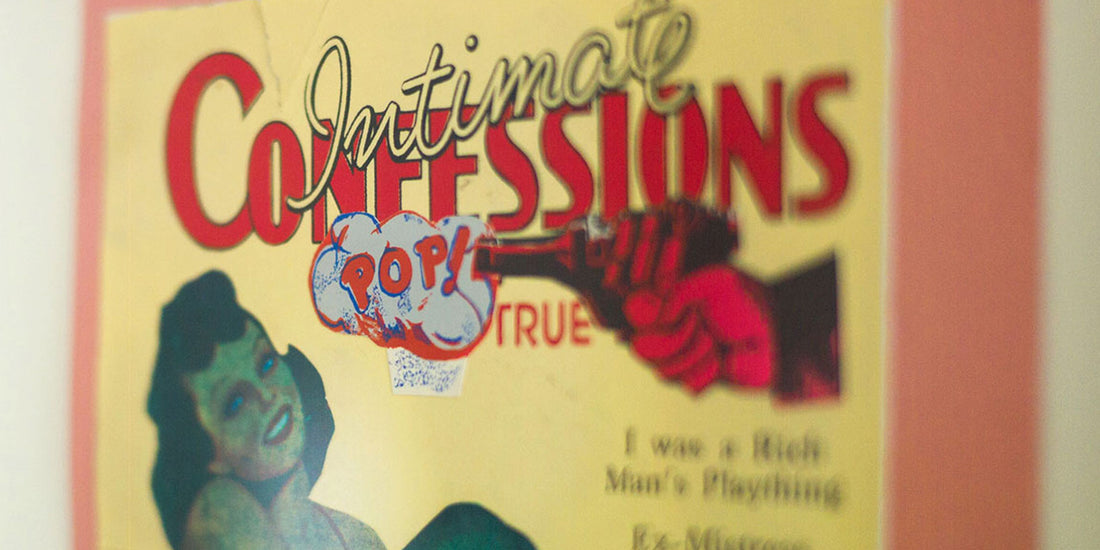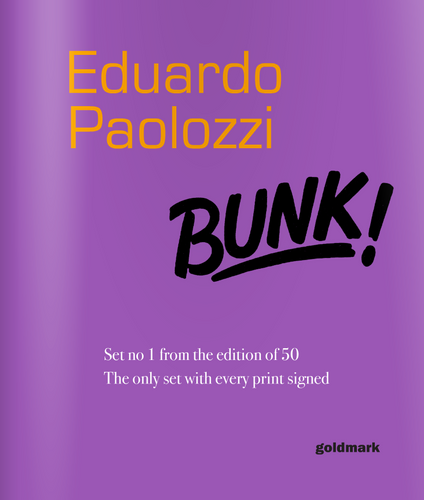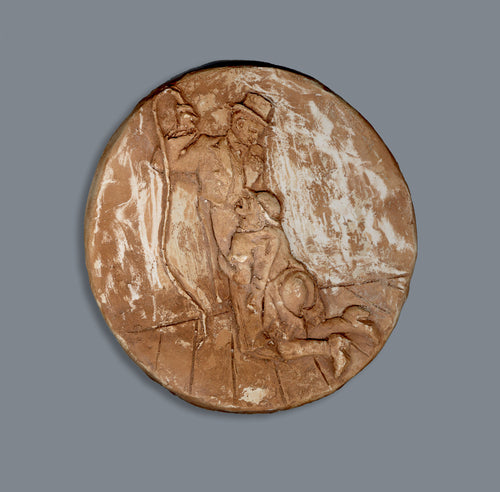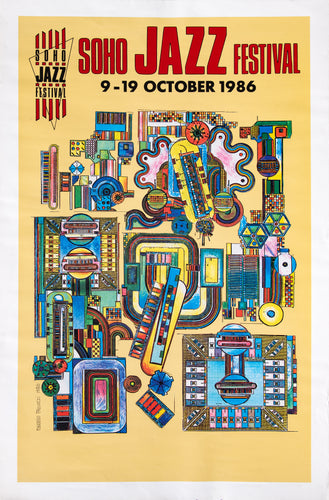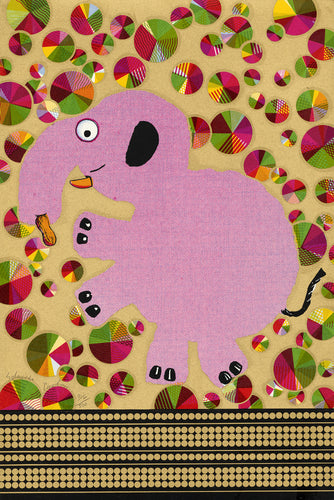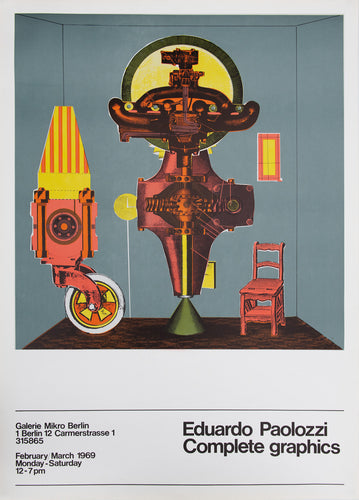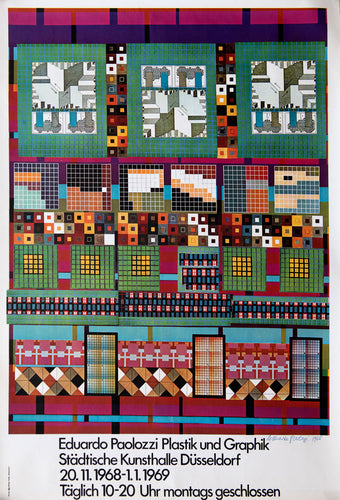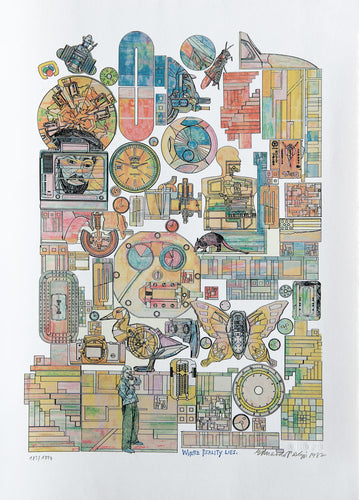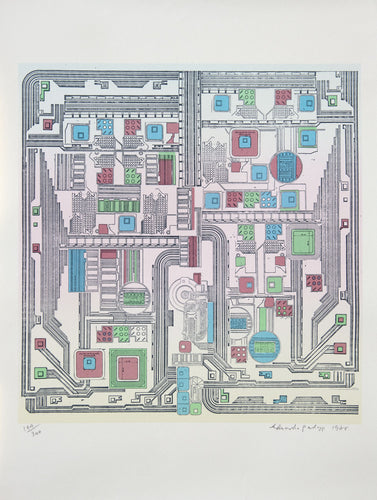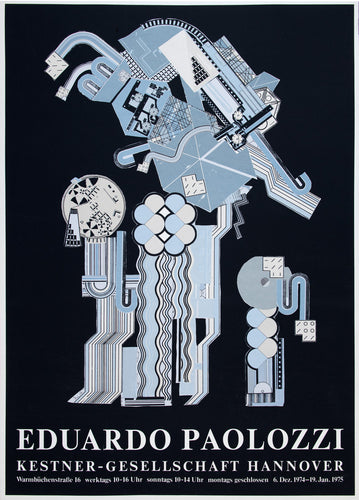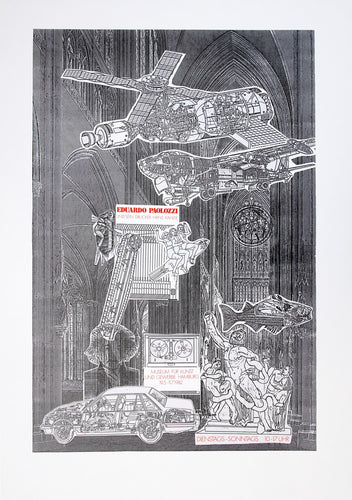Eduardo Paolozzi, founder of the Independent Group of artists, presents a groundbreaking lecture to its members at the Institute of Contemporary Art. Entitled Bunk, Paolozzi’s talk starts with an optical projector. Under its white-hot lamp he slides projection after projection of clustered collages made from magazine clippings, newspaper shreds, commercial copy, pin-up postcards - all manner of refuse, poring over details and discussing their cultural and artistic value. In a single presentation, he changes the face of 20th century art forever: the notion of ‘Pop Art’ is born.
 Evadne in Green Dimension
Evadne in Green Dimension
Where the title of the suite came from remains a debated topic: some critics note the word appearing as a detail in the more prominent collage Evadne in Green Dimension; others have suggested derivation from Henry Ford’s infamous pronouncement that History is more or less bunk… We want to live in the present. Certainly, Paolozzi’s Bunk collages, produced in post-war Paris throughout the late 1940s, formed a defining statement in British art: that the graphics of ad agencies and commercial business contributed more to the world of images than anything produced by contemporary artists at that time.
 Headline from Horrors Ville
Headline from Horrors Ville
So visually and technically virtuosic were they, in fact, that they needed no alteration; only curation and collection on the page. Material for the collages was sourced principally from American G.I.s stationed in the city after the war had ended, who willingly handed over the otherwise discarded popular magazines and pulp fiction novels from which he began to compile his images.
 detail from 'Meet the People'
detail from 'Meet the People'
The medium of collage held a personal significance for Paolozzi. A child of the interwar years, he had grown up in a society in which nothing was left to waste. As a young boy, he had made scrapbooks from collected ephemera, sketching on pieces of recycled paper and unwanted broadsheet features. All human experience is one big collage, Paolozzi once said; for the artist, literally so, it seemed.
 Paolozzi's 'Bunk', on the wall and in detail
Paolozzi's 'Bunk', on the wall and in detail
Despite the significance with which they had been presented, however, Paolozzi abandoned the Bunk images after their emphatic reveal, only rediscovering them some 20 years later as he prepared for a 1971 retrospective at the Tate. It had taken the two intervening decades of Pop Art development to realise how prescient they had been; Frank Whitford describes in the portfolio foreword how farsighted the suite later seemed:
According to one of those present [at the lecture], ‘the very notion of culture changed before one’s eyes’… Already in 1952 it was all there: science fiction, sex, technology, the movies, mass advertising, comics, packaging. A source-book of images prepared for future historians and sociologists who may want to tell our story in pictorial symbols. The ephemeral had been raised to the level of art; the underrated, undervalued and misunderstood had been proposed as the key to an understanding of contemporary culture.
 The Ultimate Planet
The Ultimate Planet
47 of the collages were chosen by Paolozzi to be replicated in an edition of 150 facsimiles, 50 of which would be produced as specials, signed and numbered by the artist himself (though only one full set - the one we have acquired and which is illustrated here - would be signed on every print). Chris Betambeau of Advanced Graphics, a technician who had worked in the famous Kelpra Studios until the late 1960s, was sought out as the printer for what would be a challenging task of translation.
 Will Man Outgrow the Earth?
Will Man Outgrow the Earth?
The method by which each collage was facsimiled was not just lengthy, complex, and involved; it made for a strange and subversive statement in and of itself. Individual elements of the original collage were artificially reproduced by combinations of lithography and screenprinting. These printed pieces were then torn, folded, and creased by hand to mimic the collated scraps before being pasted onto sheets, making identical ‘impressions’ of the original collage.
 advertisements abound throughout the suite
advertisements abound throughout the suite
The process was both effective and absurd, as Paolozzi expert Rosemary Miles later wrote: The ‘original’ was of course unique, but made up of mass produced articles. It was then ‘mass produced’ itself but by an exceptionally skilled craftsman… Technically, this was a highly sophisticated, paradoxical comment on production and mass production; iconographically it was an ultimate statement.
 Was this Metal Monster Master or Slave?
Was this Metal Monster Master or Slave?
A technical and visionary masterpiece, Paolozzi’s Bunk presents us with a suspension of time, frozen moments from another generation that invite us into a visual world long since passed. In its combinations of photography and illustration, milk-skinned poster girls and science fiction androids, it offers a rich social and cultural tapestry from ordinary, everyday scenes; and in its exacting method of reproduction, it immortalized not just the time from which each collected element originated, but the creative act of the collage itself.
 Paolozzi's signature adorns each print in only one special edition out of fifty - the one we have been lucky enough to acquire
Paolozzi's signature adorns each print in only one special edition out of fifty - the one we have been lucky enough to acquire
In a 1960 interview, Paolozzi spoke of how he was interested, above all, in the golden ability of the artist to achieve a metamorphosis of quite ordinary things into something wonderful and extraordinary…the sublime of everyday life. Ultimately, Bunk was always far more than the sum of its compiled parts: it repreesented an artistic, historical, and anthropological landmark, a powerful human document, and one of the most influential aesthetic projects of the 20th century.
